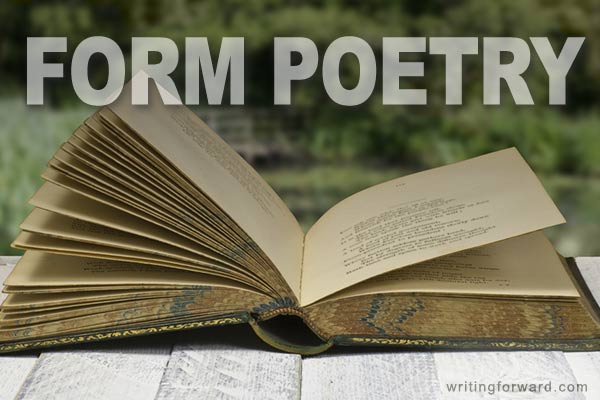We can classify most poetry into two groups: form poetry and free verse. Free verse is a style of poetry that doesn’t adhere to any structure; the poet is free to write lines and stanzas of varying lengths and meter, with or without rhymes.
Form poetry, on the other hand, adheres to a specific structure, a formula that drives the entire poem based on a set of established rules and patterns.
Introduction to Form Poetry: Learning the Rules
There are various elements of a poem that can be specified by form poetry: meter, rhyme scheme, the number of lines in a stanza, and the total number of stanzas.
For example, a Shakespearean sonnet is composed of three quatrains with a couplet at the end. It is written in iambic pentameter with the following rhyme scheme: abab cdcd efef gg. This form is sometimes called the English sonnet.
Some forms go even further than structure. For example, traditional haiku deals with nature.
Additionally, some patterns can refer to a stanza within a poem or an entire poem. A quatrain is a stanza of four lines, usually with alternate rhymes. A quatrain can comprise an entire poem, or it can be used within the pattern of a larger poem, as is the case with sonnets.
Some other examples of form poetry include the cento, the double dactyl, and the pantoum, to name a few.
Benefits of Writing Form Poetry
Many young and new poets find form poetry constricting at first. Others enter the world of poetry believing that a poem must adhere to some kind of form in order for it to be legitimate poetry. That’s not true. Free verse and prose poems are perfectly legitimate types of poems. And form poetry is not as constricting as it may first appear.
The blank page can be intimidating. Sometimes guidelines, such as those that are provided by form poetry, can help us focus on the content and substance of our writing, especially when we’re learning the basics of various forms of writing.
Writing within a structure removes various problems from the process of making a poem. For example, if we’re writing a sonnet, we don’t need to worry about how many lines or stanzas it should contain, what kind of rhyme scheme we should use, or what meter to apply. These elements of the poem are already established. This frees up a poet to focus on other aspects of a poem, such as language and word choice, subject matter, and flow.
When I was studying poetry, I found form especially useful for studying and practicing rhyme. Novice poets often use forced rhymes, awkward word order, inaccurate or imprecise word choices, and stilted language to fit a poem’s meter or rhyme scheme. I found that working within an established structure allowed me to focus less on rhythm and meter and more on rearranging my words and searching for the best possible language for my poems.
Do You Write Form Poetry?
Have you ever written form poetry? Do you prefer to write poetry in form or in free verse? What are some of your favorite forms (I love haiku!)? Share your thoughts about form poetry by leaving a comment, and keep writing.





I have written form poetry, though not a lot. Plan to do more. First form poem was a quatrain and found it enjoyable. Later I gathered up the nerve to try a sonnet:rhyming was a big challenge but one am planning to master;) Love haiku and other similar forms.
That’s great, Carol. I’ve always found writing poetry excellent for learning various techniques, but I also love a good poem!
I’ve done quite a lot of form poetry in the past. I have great respect for the strict rules. It’s a challenge, but an elegant practice.
I agree that it’s a challenge, but I think it’s a good challenge to undertake.
I have written many poems in a certain type of “form” and I enjoy being able to have rules to follow. I also write freestyle poetry and I like that as well. Poetry is such a diverse type of writing…let yourself go and write a poem in form today…I think you will like it!
~Sharon
Sometimes writing in form is even easier than writing free verse, because the guidelines of form give you some direction, whereas with free verse, there are no rules. Keep writing!
I love structured poetry writing. I’ll often challenge myself by using a rhyming sequence and syllable counts. I find greater satisfaction as I complete my poems.
That’s a good challenge, David!
Haiku is one of my favorites–in fact, I’m putting togethr a haiku collection. I also have fun writing limericks. Poems with rhyme schemes seem to work well for me too. Haven’t attempted free verse yet and still have many structured poetry forms to attempt.
Haiku is one of my favorites, too. I would encourage you to give free verse a try. It can be a lot of fun to write.
Although I enjoy writing and reading short form poetry such as the Haiku, form poetry with it’s innate metre, rhythm and rhyme has been and always will remain the truest to the art. Free verse is memorable only for it’s ofthe moment quality not the capacity for re-telling.
I don’t view any form “truer” than any other. What’s wonderful about poetry (and writing in general) is that there are plenty of options…something for everyone!
Unrhying poems aren’t poems at all. I really enjoy couplets and quatrains. Bruce Lansky, Kenn Nesbitt, Roald Dahl , and Edward Lear are wonderful poets. Free verse is usually garbage. It’s a license to write garbage and no one will tell you it’s garbage because they don’t want to hurt your feelings. That’s why a lot of bad poetry is written today. If you want to read well written poems, read poems for children. You can learn a lot from Children’s poets.
Actually, poems that don’t rhyme are, indeed, poems, and free verse, collectively, is not garbage. You certainly don’t have to like them, and that’s fair enough. Saying something isn’t what it is and calling something else garbage isn’t exactly comprehensive or constructive criticism. What I’m trying to say is that is you haven’t made any substantial argument to support your case. I happen to like free verse. I have studied and written it. I don’t expect other people to like it, and I don’t care if they do. I don’t say that for the benefit of anybody’s feelings. Maybe you go around expressing a false opinion on poetry (which sounds like lying, if you ask me) to save other people’s feelings. I don’t.
By the way, if you’re going to run around the internet being nasty and critical about the literary arts, I’d suggest you proofread before posting. Your comment contains multiple errors. Have a good one!
Although I have written unrhyming poems, Cynthia, I agree with you about free verse, on the whole. My unrhyming poems all have metre.
My view of free verse is that it is simply a piece of prose broken into lines. Usually seemingly arbitrarily. (What a dreadful sentence.)
As for ‘prose poems’; what’s that all about? Is it prose, or is it a poem? Can’t be both as they are opposites.
I do like haiku, tanka, and other Japanese forms, though.
I heard a free form poem on the radio the other day. I thought it was a piece of prose until someone said it was a poem.
I’m not denying that some of them are poetic, but that doesn’t make them a poem.
‘Novice poets often use forced rhymes, awkward word order, inaccurate or imprecise word choices, and stilted language to fit a poem’s meter or rhyme scheme’ – that’s me in a sentence, but I’m working on it. I still prefer to write using rhyme and rhythm (meter doesn’t somehow describe it…).
I contribute to a “12 poems in 12 months” challenge and am beginning to dip a toe into the ocean of free verse, but I’m not confident that what I’m writing is poetry.
Whenever the challenge is specific about rhyme or form, I notice that many of the poets contributing struggle with their poems, so I suppose it depends on what you’re most familiar with.
I started writing poetry when I was a teenager, and I was in my twenties by the time I got used to the idea that some poems don’t rhyme. I think all the early poems I read were rhyming poems and the non-rhyming ones I discovered later just didn’t seem like “real” poetry. But of course they are real poetry. Give it time. Good luck!
A poem doesn’t need to rhyme, but it MUST have metre, otherwise how does it differ from a piece of prose?
One way it might be different is that it could be written in verse.
There is no list of specifications that absolutely makes a poem a poem. Not rhyme, not meter, not even being written in verse. The reason for this is that there are always exceptions. You will find a poem without meter that is a poem, not prose. It’s out there. I’m not sure why people have a need for absolutes regarding what qualifies a piece of writing as poetry. There are some common traits we see in poetry (meter, rhyme, verse), but there are no absolutes, and there will always be exceptions.